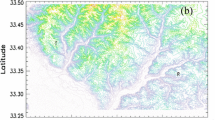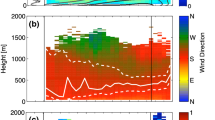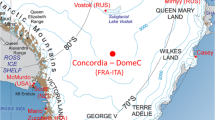Abstract
The nocturnal stable boundary layer (SBL) can generally be classified into the weakly stable boundary layer (wSBL) and very stable boundary layer (vSBL). Within the wSBL, turbulence is relatively continuous, whereas in the vSBL, turbulence is intermittent and not well characterized. Differentiating characteristics of each type of SBL are still unknown. Herein, thermodynamic and kinematic data collected by a suite of instruments in north central Oklahoma in autumn 2012 are analyzed to better understand both SBL regimes and their differentiating characteristics. Many low-level jets were observed during the experiment, as it took place near a climatological maximum. A threshold wind speed, above which bulk shear-generated turbulence develops, is found to exist up to 300 m. The threshold wind speed must also be exceeded at lower heights (down to the surface) in order for strong turbulence to develop. Composite profiles, which are normalized using low-level jet scaling, of potential temperature, wind speed, vertical velocity variance, and the third-order moment of vertical velocity (\(\overline{w'^3}\)) are produced for weak and moderate/strong turbulence regimes, which exhibit features of the vSBL and wSBL, respectively. Within the wSBL, turbulence is generated at the surface and transported upward. In the vSBL, values of vertical velocity variance are small throughout the entire boundary layer, likely due to the fact that a strong surface inversion typically forms after sunset. The temperature profile tends to be approximately isothermal in the lowest portions of the wSBL, and it did not substantially change over the night. Within both types of SBL, stability in the residual layer tends to increase as the night progresses. It is thought that this stability increase is due to differential warm air advection, which frequently occurs in the southern Great Plains when southerly low-level jets and a typical north–south temperature gradient are present. Differential radiative flux divergence also contributes to this increase in stability.










Similar content being viewed by others
References
Banta RM, Pichugina YL, Brewer WA (2006) Turbulent velocity-variance profiles in the stable boundary layer generated by a nocturnal low-level jet. J Atmos Sci 63:2700–2719
Banta RM, Mahrt L, Vickers D, Sun J, Balsley BB, Pichugina YL, Williams EJ (2007) The very stable boundary layer on nights with weak low-level jets. J Atmos Sci 64:3068–3090
Bonner WD (1968) Climatology of the low level jet. Mon Weather Rev 96:833–850
Browning KA, Wexler R (1968) The determination of kinematic properties of a wind field using Doppler radar. J Appl Meteorol 7:105–113
Carrico CM, Rood MJ (1998) Aerosol light scattering properties at Cape Grim, Tasmania, during the first aerosol characterization experiment (ACE 1). J Geophys Res 103:16,565–16,574
Clough SA, Iacono MJ, Moncet JL (1992) Line-by-line calculations of atmospheric fluxes and cooling rates: application to water vapor. J Geophys Res 97:15,761–15,785
Cook DR (2011) Eddy correlation flux measurement system handbook. Department of Energy, DOE/SC-ARM/TR-052
Coulter RL (1990) A case study of turbulence in the stable nocturnal boundary layer. Boundary-Layer Meteorol 52:75–91
Cuxart J, Jiménez MA (2007) Mixing processes in a nocturnal low-level jet: an LES study. J Atmos Sci 64:1666–1679
Derbyshire SH (1990) Nieuwstadt’s stable boundary layer revisited. Q J R Meteorol Soc 116:127–158
Edwards JM (2009) Radiative process in the stable boundary layer: Part I Radiative aspects. Boundary-Layer Meteorol 131:105–126
Einaudi F, Finnigan JJ (1993) Wave-turbulence dynamics in the stabily stratified boundary layer. J Atmos Sci 50:1841–1864
Estournel C, Guedalia D (1985) Influence of geopstrophic wind on atmospheric nocturnal cooling. J Atmos Sci 42:2695–2698
Ha KJ, Mahrt L (2003) Radiative and turbulent fluxes in the nocturnal boundary layer. Tellus 55:317–327
Kaimal JC, Finnigan JJ (1994) Atmospheric boundary layer flows: their structure and measurement. Oxford University Press, New York, 304 pp
Kallistratova MA, Kouznetsov RD, Kramar VF, Kuznetsov DD (2013) Profiles of wind speed variances within nocturnal low-level jets observed with a sodar. J Atmos Ocean Technol 30:1970–1977
Kasten F (1969) Visibility forecast in the phase of pre-condensation. Tellus 5:631–635
Klein P, Bonin TA, Newman JF, Turner DD, Chilson PB, Wainwright CE, Blumberg WG, Mishra S, Carney M, Jacobsen EP, Wharton S, Newsom RK (2015) LABLE: a multi-institutional, student-led, atmospheric boundary-layer experiment. Bull Am Meteorol Soc. doi:10.1175/BAMS-D-13-002671
Knuteson RO, Revercomb HE, Best FA, Ciganovich NC, Dedecker RG, Dirkx TP, Ellington SC, Feltz WF, Garcia RK, Howell HB, Smith WL, Short JF, Tobin DC (2004a) Atmospheric emitted radiance interferometer. Part 1: Instrument design. J Atmos Ocean Technol 21:1763–1776
Knuteson RO, Revercomb HE, Best FA, Ciganovich NC, Dedecker RG, Dirkx TP, Ellington SC, Feltz WF, Garcia RK, Howell HB, Smith WL, Short JF, Tobin DC (2004b) Atmospheric emitted radiance interferometer. Part II Instrument performance. J Atmos Ocean Technol 21:1777–1789
Lenschow DH, Wulfmeyer V, Senff C (2000) Measuring second- through fourth-order moments in noisy data. J Atmos Ocean Technol 17:1330–1347
Mahrt L (1999) Stratified atmospheric boundary layers. Boundary-Layer Meteorol 90:375–396
Mahrt L (2010) Common microfronts and other solitary events in the nocturnal boundary layer. Q J R Meteorol Soc 136:1712–1722
Mahrt L (2011) The near-calm stable boundary layer. Boundary-Layer Meteorol 105:351–363
Mahrt L (2014) Stably stratified atmospheric boundary layers. Annu Rev Fluid Mech 46:23–45
Mahrt L, Vickers D (2002) Contrasting vertical structures of nocturnal boundary layers. Boundary-Layer Meteorol 105:351–363
Monin AS, Yaglom AM (1979) Statistical fluid mechanics. MIT Press, Cambridge, 874 pp
Nathanson FE (1969) Radar design principles. McGraw-Hill, New York 394 pp
Newsom RK, Banta RM (2003) Shear-flow instability in the stable nocturnal boundary layer as observed by Doppler lidar during CASES-99. J Atmos Sci 60:16–33
Newsom RK, Berg LK, Shaw WJ, Fischer ML (2015) Turbine-scale wind field measurements using dual-Doppler lidar. Wind Energy 18:219–235
Nieuwstadt FTM (1984) The turbulent structure of the stable, nocturnal boundary layer. J Atmos Sci 41:2202–2216
Prabha TV, Leclerc MY, Karipot A, Hollinger DY, Mursch-Radlgruber E (2008) Influence of nocturnal low-level jets on eddy-covariance fluxes over a tall forest canopy. Boundary-Layer Meteorol 126:219–236
Rodgers CD (2000) Inverse methods for atmospheric sounding: theory and practice. World Scientific, Singapore pp. 238
Savijärvi H (2006) Radiative and turbulent heating rates in the clear-air boundary layer. Q J R Meteorol Soc 132:147–161
Shapiro A, Fedorovich E (2010) Analytical description of a nocturnal low-level jet. Q J R Meteorol Soc 136:1255–1262
Soler MR, Udina M, Ferreres E (2014) Observational and numerical simulation study of a sequence of eight atmospheric density currents in northern Spain. Boundary-Layer Meteorol 153:195–216
Song J, Liao K, Coulter RL, Lesht BM (2005) Climatology of the low-level jet at the southern great plains atmospheric boundary layer experiments site. J Appl Meteorol 44:1593–1606
Steeneveld GJ, Wokke MJJ, Groot Zwaaftink CD, Pijlman S, Heusinkveld BG, Jacobs AFG, Holtslag AAM (2010) Observations of the radiation divergence in the surface layer and its implication for its parameterization in numerical weather prediction models. J Geophys Res 115:D06,107
Sun J (2011) Vertical variations of mixing lengths under neutral and stable conditions during CASES-99. J Appl Meteorol Clim 50:2030–2041
Sun J, Burns SP, Lenschow DH, Banta R, Newsom R, Coulter R, Frasier S, Ince T, Nappo C, Cuxart J, Blumen W, Lee X, Hu XZ (2002) Intermittent turbulence associated with a density current passage in the stable boundary layer. Boundary-Layer Meteorol 105:199–219
Sun J, Mahrt L, Banta RM, Pichugina YL (2012) Turbulence regimes and turbulence intermittency in the stable boundary layer during CASES-99. J Atmos Sci 69:338–351
Sun J, Mahrt L, Nappo C, Lenschow DH (2014) Wind and temperature oscillations generated by wave-turbulence interactions in the stabily stratified boundary layer. J Atmos Sci. doi:10.1175/JAS-D-14-0129.1
Turner DD (2014) Updated yearly. ARM AERIoe thermodynamic profile and cloud retrieval for SGP CF during LABLE-2012. Sep 2012 – Nov 2012, 36\(^\circ \) 9’ 6.0” W Southern Great Plains Central Facility (c1). Atmospheric Radiation Measurement (ARM) Climate Research Facility Data Archive, Oak Ridge. doi:10.5439/1162180
Turner DD, Löhnert U (2014) Information content and uncertainties in thermodynamic profiles and liquid cloud properties retrieved from the ground-based atmospheric emitted radiance interferometer (AERI). J Appl Meteorol Clim 53:752–771
Turner DD, Knuteson RO, Revercomb HE, Lo C, Dedecker RG (2006) Noise reduction of atmospheric emitted radiance interferometer (AERI) observations using principal component analysis. J Atmos Ocean Technol 23:1223–1238
Van de Wiel BJH, Moene AF, Jonker HJJ (2012a) The cessation of continuous turbulence as precursor of the very stable nocturnal boundary layer. J Atmos Sci 69:3097–3115
Van de Wiel BJH, Moene AF, Jonker HJJ, Baas P, Basu S, Donda JMM, Sun J, Holtslag AAM (2012b) The minimum wind speed for sustainable turbulence in the nocturnal boundary layer. J Atmos Sci 69:3116–3127
Van Hooijdonk IGS, Donda JMM, Clercx HJH, Bosveld FC, van de Wiel BJH (2015) Shear capacity as prognostic for nocturnal boundary layer regimes. J Atmos Sci 72:1518–1532
Acknowledgments
We acknowledge everyone who helped to deploy and maintain the instruments during LABLE-I. Additionally, we thank Dave Turner for his help in interpreting observations from the AERI. This study was supported by funding from the Office of the Vice President for Research at the University of Oklahoma. The instruments deployed were in part funded through the NSF Career award ILREUM (NSF ATM 0547882). Data from the ARM SGP site were obtained from the Atmospheric Radiation Measurement (ARM) Program sponsored by the US Department of Energy, Office of Science, Office of Biological and Environmental Research, Climate and Environmental Sciences Division.
Author information
Authors and Affiliations
Corresponding author
Rights and permissions
About this article
Cite this article
Bonin, T.A., Blumberg, W.G., Klein, P.M. et al. Thermodynamic and Turbulence Characteristics of the Southern Great Plains Nocturnal Boundary Layer Under Differing Turbulent Regimes. Boundary-Layer Meteorol 157, 401–420 (2015). https://doi.org/10.1007/s10546-015-0072-2
Received:
Accepted:
Published:
Issue Date:
DOI: https://doi.org/10.1007/s10546-015-0072-2




